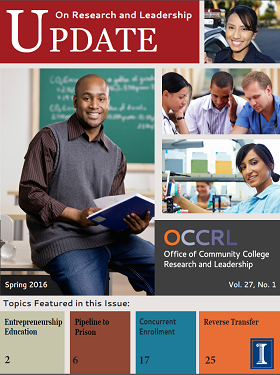Welcome to an issue of Update like no other! As you read our newest edition you will notice fresh perspectives on timely topics plus a fresh new look. You can read our interactive version online. We are pleased that 2016 ushers in a new slate of featured articles that bring attention to important trends and current issues of importance to the community college sector.
Community colleges are an essential mechanism for providing opportunities for students not traditionally nurtured by four-year institutions. Among the multiple postsecondary pathways that community college offer, entrepreneurship programs have become what Paul Magelli refers to as the “Third Pathway.” In an interview with Janice Li North, Magelli shares how community colleges are preparing students with business skills and exposing them to entrepreneurial development.
Besides entrepreneurial development, workforce development has remained a high priority for community colleges. Workforce training and development have also been priorities of the Obama administration. In 2010, President Obama authorized $2 billion dollars to fund the Trade Adjustment Assistance Community College and Career Training (TAACCCT) Grant Program over four years through signing the Health Care and Education Reconciliation Act. Debra Bragg, Matthew Giani, and Heather Fox share findings from the Health Professions Pathways Consortium’s efforts to expand and improve healthcare education and employment success in this high growth industry sector.
The health of our nation is dependent on fueling the pipeline to college and degree completion. Kadeem Fuller and I discuss the growing pipeline to prison and how community colleges promote postsecondary educational access behind bars. In addition, community colleges are known for providing other alternative on-ramps to higher learning. In the case of dual credit/dual enrollment programs, they offer an accelerated pathway. Ken Sheffel, President of the National Alliance of Concurrent Enrollment Partnerships (NACEP) explains three views on concurrent enrollment – illuminating the local, state, and national context for these initiatives.
Another means of expediting baccalaureate attainment are applied baccalaureate (AB) degree programs. Recent research on the implementation of AB programs across the country is presented by Debra Bragg and Maria Soler Salazar. Rounding out this issue of Update on Research and Leadership, Jason Taylor and Matthew Giani turn the spotlight on yet another route to the baccalaureate with reverse transfer of credit. While many students leave community colleges without credentials, new articulation agreements to award associate degrees are emerging. Taylor and Giani tell us about the Credit When It’s Due (CWID) initiative and initial findings on reverse transfer practices in 15 states.
We hope you find our new format featuring flip page e-reading engaging as well as lengthier articles that boasts bold colors, graphics, and most importantly content. If you like what’s in this issue, feel free to share via Twitter, LinkedIn and Facebook.
